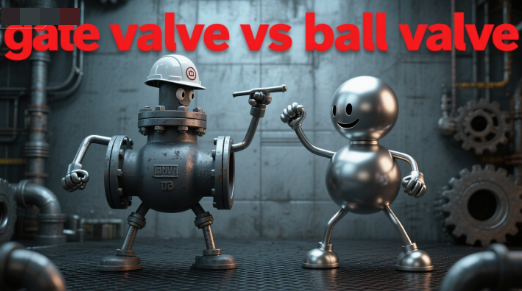صمام البوابة مقابل صمام الكرة: المواجهة النهائية
مرحباً بكم في مدونتي!
يسعدني وجودك هنا! قبل أن نتعمق في المحتوى، أود أن تنضموا إليّ على منصات التواصل الاجتماعي. هناك أشارككم أفكارًا إضافية، وأتواصل مع مجتمعنا الرائع، وأُطلعكم على آخر الأخبار. إليكم كيفية البقاء على تواصل:
📘 فيسبوك: شركة شنغهاي لييروو الصناعية التجارية المحدودة
الآن، لننطلق في هذه الرحلة معًا! آمل أن تجدوا هذا المحتوى مفيدًا ومُلهمًا وقيّمًا. هيا بنا!
جدول المحتويات
مقدمة

في عالم أنظمة التحكم في السوائل، قد يُحدث اختيار الصمام المناسب فرقًا بين الأداء الفعال والخالي من التسربات، وبين تكاليف الصيانة الباهظة أو عدم الكفاءة التشغيلية. من بين الخيارات الأكثر شيوعًا صمامات البوابة وصمامات الكرة. صمام البوابة مقابل صمام الكرة استمر الجدل في القطاعات الصناعية والتجارية والسكنية لعقود، ولسبب وجيه. يعمل كلا النوعين من الصمامات على تنظيم تدفق السوائل والغازات، ولكنهما يقومان بذلك بطرق مختلفة تمامًا.
إن فهم الفروقات والمزايا والعيوب الرئيسية لصمامات البوابة والصمامات الكروية يُساعد المهندسين وفرق المشتريات، وحتى مُحبي الأعمال اليدوية، على اتخاذ قرارات أفضل. سواء كنت تُخطط لنظام سباكة، أو تُحدّث خط أنابيب، أو تعمل في بيئة صناعية عالية الضغط، فإن هذه المقارنة الشاملة ستُرشدك في اختيار نوع الصمام الأنسب لاحتياجاتك.
يستكشف هذا الدليل الشامل جميع الجوانب المهمة لاختيار صمام البوابة مقابل صمام الكرة، بما في ذلك آليات التشغيل، وتحمل الضغط، والصيانة، والتكلفة، وحالات الاستخدام الشائعة. دعونا نتعمق في المواجهة بين هذين المكونين الرائدين في عالم الصمامات.
كيف تعمل صمامات البوابة مقابل كيف تعمل صمامات الكرة
إن فهم الميكانيكا الداخلية لهذين النوعين من الصمامات أمر ضروري لتقييم مدى ملاءمتها لتطبيقات محددة.
تشغيل صمامات البوابة
تعمل صمامات البوابة بحركة خطية. عند تدوير المقبض أو المشغل، يتحرك قرص يشبه البوابة لأعلى ولأسفل للسماح بالتدفق أو منعه. عند فتحها بالكامل، تكون البوابة خارج مسار السائل تمامًا، مما يقلل من انخفاض الضغط عبر الصمام. هذا يجعلها مثالية للتطبيقات التي تتطلب تقليل تقييد التدفق إلى أدنى حد. مع ذلك، لا تُناسب صمامات البوابة أغراض التحكم في التدفق، حيث قد تُسبب البوابات المفتوحة جزئيًا اضطرابًا واهتزازًا.
تشغيل صمامات الكرة
من ناحية أخرى، تستخدم صمامات الكرة كرة دوارة ذات ثقب في مركزها. عند تدوير المقبض، تدور الكرة لمحاذاة الثقب مع خط الأنابيب، مما يسمح بمرور السائل. يؤدي تدوير الكرة بزاوية 90 درجة إلى منع التدفق تمامًا. تتميز هذه العملية التي تتم بربع دورة بالسرعة والكفاءة، مما يجعل صمامات الكرة الخيار الأمثل لتطبيقات الإغلاق السريع.
المواد والتصميم: صمام البوابة مقابل صمام الكرة الاختلافات

لا تقتصر الاختلافات التصميمية بين صمامات البوابة وصمامات الكرة على المظهر أو الحجم فحسب، بل إن تركيبها الداخلي واختيار موادها يؤثران بشكل كبير على أدائها وعمرها الافتراضي.
تصميم صمام البوابة
عادةً ما تأتي صمامات البوابة بجذع صاعد أو غير صاعد. يُصنع هيكل الصمام عادةً من مواد مثل الحديد الزهر، أو الحديد المطاوع، أو الفولاذ المقاوم للصدأ، أو النحاس الأصفر. يجب أن يُحكم الإسفين أو البوابة داخل الصمام إغلاقها بإحكام على قواعد الصمام، والتي قد تتآكل بمرور الوقت، خاصةً في التطبيقات التي تحتوي على شوائب أو قشور.
تصميم صمام الكرة
صمامات الكرة عادةً ما تكون أكثر إحكامًا، وتتضمن كرةً مثقوبةً، تُركّب بين قواعد PTFE أو معدنية. سطح الإغلاق في صمام الكرة أقل عرضة للتآكل مقارنةً ببوابة صمام البوابة، مما يجعله خيارًا أفضل في التطبيقات التي تتطلب دورات تشغيل وإيقاف متكررة.
التطبيقات: متى تختار؟ صمام البوابة مقابل صمام الكرة
تتطلب البيئات والمتطلبات التشغيلية المختلفة أنواعًا مختلفة من الصمامات. تُقدم مقارنة أداء صمام البوابة مع صمام الكرة في حالات استخدام مختلفة معلومات قيّمة.
تطبيقات صمام البوابة
- أنظمة إمدادات المياه
- محطات معالجة مياه الصرف الصحي
- خطوط أنابيب النفط والغاز
- أنظمة الحماية من الحرائق
- البيئات منخفضة الضغط
تُستخدم صمامات البوابة على نطاق واسع في الحالات التي تبقى فيها الصمامات مفتوحة أو مغلقة لفترات طويلة. وهي غير مناسبة للتشغيل المتكرر أو التحكم الدقيق في التدفق.
تطبيقات صمام الكرة
- أنظمة الهواء المضغوط
- خطوط توزيع الغاز
- التطبيقات البحرية
- تجهيز الأغذية والمشروبات
- المصانع الكيميائية
صمامات الكرة مثالية للعمليات التي تتطلب فتحًا وإغلاقًا متكررًا. إحكام إغلاقها وسهولة تشغيلها يجعلها قيّمة بشكل خاص في البيئات عالية الضغط والتآكل.
جدول المقارنة الوسطى: صمام البوابة مقابل صمام الكرة نظرة عامة
يوضح الجدول التالي الاختلافات الرئيسية بين صمام البوابة وصمام الكرة:
| ميزة | صمام البوابة | صمام كروي |
|---|---|---|
| طريقة التشغيل | الحركة الخطية (متعددة الدورات) | الدوران (ربع دورة) |
| تنظيم التدفق | ليس مثاليًا للخنق | غير مناسب للخنق |
| آلية الختم | إسفين البوابة مقابل مقعد الصمام | كرة بها ثقب بين المقاعد |
| سرعة الفتح/الإغلاق | بطيئ | سريع |
| الحجم والمساحة | أكبر | مضغوط |
| احتياجات الصيانة | أعلى | أدنى |
| يكلف | أقل عموما | أعلى قليلا |
| المتانة في الوسائط القاسية | معتدل | عالي |
| أفضل حالات الاستخدام | الماء والنفط والحماية من الحرائق | الغاز والمواد الكيميائية والتدفق عالي الضغط |
توفر هذه النظرة العامة مرجعًا سريعًا للمهندسين والمشترين الذين يزنون إيجابيات وسلبيات كل نوع من أنواع الصمامات.
الصيانة وعمر الخدمة: صمام البوابة مقابل صمام الكرة الاعتبارات

يمكن أن يؤدي الصيانة المناسبة إلى إطالة عمر أي صمام، ولكن مستوى الجهد والمتانة على المدى الطويل يختلف بشكل كبير بين تصميمات صمام البوابة وصمام الكرة.
احتياجات صيانة صمامات البوابة
تتطلب صمامات البوابة فحصًا وتنظيفًا دوريًا لمنع تراكم الترسبات أو التآكل على البوابة وقاعدتها. في الأنظمة التي تحتوي على رواسب أو حطام، قد تلتصق البوابة أو تفشل في الإغلاق، مما يتطلب تفكيكها وتنظيفها. مع مرور الوقت، قد تحتاج ساق البوابة أو قاعدتها إلى الاستبدال بسبب التآكل أو البلى.
احتياجات صيانة صمامات الكرة
تتطلب صمامات الكرة عمومًا صيانة أقل بفضل قواعدها المحكمة الإغلاق وسهولة تشغيلها. قد يلزم تزييت ساق الصمام وتنظيف الكرة والأختام من حين لآخر، خاصةً في البيئات الكيميائية أو المسببة للتآكل.
مقارنة العمر الافتراضي
بفضل قلة أجزائها المتحركة وأدائها الأفضل في الغلق، تتميز صمامات الكرة عادةً بعمر خدمة أطول. ومع ذلك، يمكن لصمامات البوابة أن تدوم طويلًا أيضًا إذا استُخدمت في وسائط نظيفة وخضعت للصيانة المناسبة.
التكلفة والميزانية: هل صمام واحد أكثر تكلفة؟
التكلفة دائمًا ما تكون عاملًا مهمًا، خاصةً في المنشآت واسعة النطاق أو الاستخدامات الصناعية. دعونا نحلل الجوانب الاقتصادية في صمام البوابة مقابل صمام الكرة تحليل.
تسعير صمام البوابة
عادةً ما تكون صمامات البوابة أقل تكلفةً من حيث التكلفة الأولية، خاصةً في الأحجام الكبيرة. فبساطة تركيبها تعني انخفاض تكاليف التصنيع، خاصةً للطرازات غير المعدنية أو منخفضة الضغط.
تسعير صمام الكرة
قد تكون تكلفة صمامات الكرة أعلى، خاصةً تلك المصنوعة من سبائك عالية الجودة أو تلك التي تتطلب تصنيعًا دقيقًا لضمان إحكام الإغلاق. ومع ذلك، فإن انخفاض متطلبات الصيانة وطول عمرها الافتراضي قد يؤديان إلى انخفاض التكلفة الإجمالية للملكية بمرور الوقت.
استنتاج التكلفة والفائدة
بالنسبة للأنظمة التي تتطلب تشغيلًا متكررًا وعمرًا افتراضيًا طويلًا، غالبًا ما تُقدم صمامات الكرة قيمة أفضل. مع ذلك، تُعتبر صمامات البوابة خيارات اقتصادية للأنظمة الثابتة أو المشاريع ذات الميزانية المحدودة.
كفاءة التدفق وفقدان الضغط
تُعد كفاءة التدفق معيارًا بالغ الأهمية، لا سيما في خطوط الأنابيب ذات الحجم الكبير أو الأنظمة كثيفة الاستهلاك للطاقة.
أداء تدفق صمام البوابة
صمامات البوابة، عند فتحها بالكامل، تُقلل من تقييد التدفق إلى أدنى حد. تصميمها المستقيم يسمح بتدفق شبه خالٍ من العوائق، مما يُقلل من فقدان الضغط.
أداء تدفق صمام الكرة
توفر صمامات الكرة أيضًا كفاءة تدفق ممتازة، خاصةً في الموديلات ذات الفتحة الكاملة حيث يكون التجويف مساويًا لحجم خط الأنابيب. ومع ذلك، قد يحدث انخفاض طفيف في الضغط في الموديلات ذات الفتحة المخفضة.
ملخص
يعمل كلا الصمامين بشكل جيد من حيث كفاءة التدفق، على الرغم من أن صمامات الكرة ذات المنفذ الكامل تقدم بشكل عام أفضل النتائج.
حالات الاستخدام المتعلقة بالسلامة والطوارئ

في الأنظمة الحرجة، السلامة والإغلاق السريع أمران غير قابلين للتفاوض. صمام البوابة مقابل صمام الكرة وتظهر المقارنة في حالات الطوارئ فروقاً ملحوظة.
أداء إيقاف التشغيل في حالات الطوارئ
تتميز صمامات الكرة بسرعة إغلاقها بفضل عملها بربع دورة. هذا يجعلها الخيار الأمثل لأنظمة الطوارئ، وخطوط الغاز، وتطبيقات المواد الكيميائية الخطرة.
قد لا تكون صمامات البوابة، بآليتها البطيئة متعددة الدورات، مثاليةً عند الحاجة إلى إغلاق سريع. ومع ذلك، فهي موثوقة في حالات الإغلاق طويل الأمد حيث يكون التنشيط نادرًا.
مساحة التثبيت والمرونة
غالبًا ما تكون المساحة محدودة في الغرف الميكانيكية، أو مصانع المعالجة، أو التطبيقات البحرية. وهنا يأتي دور عامل شكل صمام البوابة مقارنةً بصمام الكرة.
متطلبات مساحة صمام البوابة
عادةً ما تكون صمامات البوابة أكبر حجمًا وتتطلب مساحة أكبر لرفع الساق أثناء الفتح. قد يُشكل هذا تحديًا في الأنظمة المدمجة.
كفاءة مساحة صمام الكرة
صمامات الكرة مدمجة، وتتطلب مساحة صغيرة، وسهلة التركيب، حتى في التركيبات الضيقة. هذا يجعلها أكثر مرونة في تصميم الأنظمة الحديثة.
خاتمة
عند تقييم صمام البوابة مقابل صمام الكرة، يعتمد القرار النهائي على متطلبات نظامك المحددة. يؤدي كلا النوعين من الصمامات وظائف قيّمة في مختلف التطبيقات الصناعية والسكنية.
اختر صمامات البوابة إذا كنت:
- هل تحتاج إلى صمام يبقى مفتوحًا أو مغلقًا معظم الوقت؟
- العمل باستخدام وسائط نظيفة تحت ضغط منخفض إلى متوسط
- هل تبحث عن تكلفة أولية أقل للأحجام الكبيرة؟
اختر صمامات الكرة إذا كنت:
- تتطلب الفتح والإغلاق بشكل متكرر
- تحتاج إلى إحكام الغلق، خاصة في الأنظمة عالية الضغط أو الخطرة
- تصميم مدمج ذو قيمة وصيانة منخفضة بمرور الوقت
في المواجهة النهائية صمام البوابة مقابل صمام الكرةلا يوجد حل واحد يناسب الجميع، بل المهم هو اختيار الأداة المناسبة للمهمة المناسبة.
الأسئلة الشائعة
ما هو الفرق الرئيسي بين صمام البوابة وصمام الكرة؟
يكمن الفرق الرئيسي بينهما في طريقة التشغيل. تستخدم صمامات البوابة بوابةً ترتفع للسماح بالتدفق، بينما تستخدم صمامات الكرة كرةً دوارةً لفتح الممر أو إغلاقه.
هل يمكن استخدام صمام البوابة بدلاً من صمام الكرة؟
يعتمد ذلك على التطبيق. تُعدّ صمامات البوابة أفضل للتحكم في التشغيل والإيقاف في أنظمة الحالة المستقرة، بينما تُعدّ صمامات الكرة أفضل للإغلاق السريع والاستخدام المتكرر.
ما هو الصمام الأكثر عرضة للتسرب؟
قد تصبح صمامات البوابة عرضة للتسريب بمرور الوقت بسبب تآكل البوابة والحطام. تتميز صمامات الكرة عمومًا بأداء إغلاق أفضل وخطر تسرب أقل.
هل صمامات الكرة أفضل لأنظمة الضغط العالي؟
نعم، خاصةً عندما يكون الإغلاق المحكم والتشغيل السريع ضروريين. تعمل صمامات الكرة بكفاءة في تطبيقات الضغط العالي، شريطة أن تكون مصنوعة من مواد مناسبة.
لماذا تستخدم بعض الأنظمة صمامات البوابة والكرة معًا؟
في الأنظمة المعقدة، يمكن استخدام كلا النوعين من الصمامات للجمع بين فوائد انخفاض الضغط في صمامات البوابة والإغلاق السريع لصمامات الكرة.
فئات المنتجات
- أجزاء الصمامات
- أجزاء مضخة المياه
- أجزاء صندوق المحمل
- أجزاء الصب بالقالب
- منتجات مضخات الفولاذ المقاوم للصدأ
- منتجات مضخات الحديد الزهر
- قطع غيار الصمامات لاستخدام السيارات
- قطع غيار السيارات
- أجزاء الصمامات للاستخدام المدني
- قطع غيار مضخة التفريغ KF

